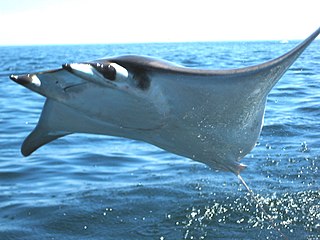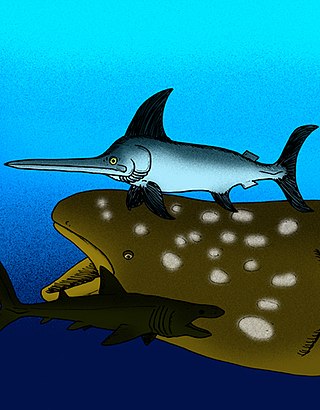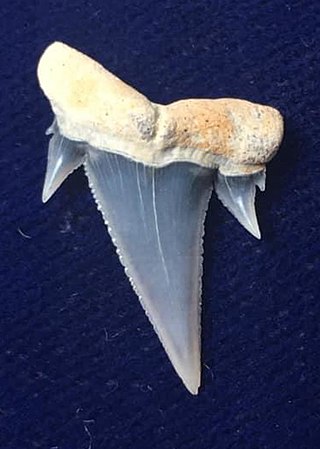
Manta rays are large rays belonging to the genus Mobula. The larger species, M. birostris, reaches 7 m (23 ft) in width, while the smaller, M. alfredi, reaches 5.5 m (18 ft). Both have triangular pectoral fins, horn-shaped cephalic fins and large, forward-facing mouths. They are classified among the Myliobatiformes and are placed in the family Myliobatidae. They have the largest brains and brain to body ratio of all fish, and can pass the mirror test.

The Mobulidae are a family of rays consisting mostly of large species living in the open ocean rather than on the sea bottom.

Carcharhinus is the type genus of the family Carcharhinidae, the requiem sharks. One of 12 genera in its family, it contains over half of the species therein. It contains 35 extant and eight extinct species to date, with likely more species yet to be described.

Mobula is a genus of rays in the family Mobulidae that is found worldwide in tropical and warm, temperate seas. Some authorities consider this to be a subfamily of the Myliobatidae. Their appearance is similar to that of manta rays, which are in the same family, and based on genetic and morphological evidence, the mantas belong in Mobula.

Otodus angustidens is a species of prehistoric megatoothed sharks in the genus Otodus, which lived during the Oligocene and Miocene epochs about 33 to 22 million years ago. The largest individuals were about 11–12 metres (36–39 ft) long. This shark is related to another extinct megatoothed shark, Otodus megalodon.

Xiphiorhynchus is an extinct genus of prehistoric swordfish that lived from the Eocene until the Oligocene. Unlike the modern swordfish, both the upper and lower jaws of Xiphiorhynchus were extended into blade-like points.
Eomysticetus is an extinct genus of baleen whale from the late Oligocene (Chattian) Chandler Bridge Formation of South Carolina.
The Belgrade Formation is a limestone geologic formation in North Carolina characterized by limestone coquina mixed with sand, and thinly laminated clays. It preserves fossils dating back to the Paleogene period.
The Ashley Formation is a geologic formation in South Carolina. It preserves fossils dating back to the Paleogene period.
The Chandler Bridge Formation is a geologic formation in South Carolina. It preserves fossils dating back to the Chattian of the Paleogene period, corresponding to the Arikareean in the NALMA classification. The formation overlies the Ashley Formation and is overlain by the Edisto Formation.
Chandler Bridge Creek is a stream in Berkeley, Charleston, and Dorchester counties in the U.S. state of South Carolina. It is a tributary of Eagle Creek, which flows into the Ashley River. The late Oligocene (Chattian) Chandler Bridge Formation, which has yielded archaic mysticetes and odontocetes, sirenians, sea birds, and turtles is named after Chandler Bridge Creek.
Eomysticetidae is a family of extinct mysticetes belonging to Chaeomysticeti. It is one of two families in the basal chaeomysticete clade Eomysticetoidea.

Coronodon is a genus of toothed (transitional) baleen whales from the Early Oligocene Ashley and Chandler Bridge formations of South Carolina. The genus contains three species: the type species C. havensteini, and additional species C. newtonorum and C. planifrons.

Agorophius is an extinct genus of toothed whale that lived during the Oligocene period, approximately 32 million years ago, in the waters off what is now South Carolina.
Xenorophus is a genus of primitive odontocete from late Oligocene (Chattian) marine deposits in South Carolina belonging to Xenorophidae.

Cotylocara is a genus of primitive odontocete from late Oligocene (Chattian) marine deposits of the Chandler Bridge Formation of South Carolina belonging to Xenorophidae.

Crenatosiren is an extinct genus of dugongid sirenian known from the late Oligocene (Chattian) of Florida, North Carolina, and South Carolina. The type and only known species is Crenatosiren olseni.
Bairdemys is an extinct genus of side-necked turtles in the family Podocnemididae. The genus existed from the Late Oligocene to Late Miocene and its fossils have been found in South Carolina, Puerto Rico, Panama and Venezuela. The genus was described in 2002 by Gaffney & Wood and the type species is B. hartsteini.

Carcharoides is an extinct genus of mackerel shark which lived during the Oligocene and Miocene epochs. It is a widespread genus, known from specimens in North and South America, Europe, Africa, and Australia. It is most common in the European portion of its range, being comparatively uncommon in other places. It is only known from isolated teeth, which are relatively delicate.

Stegosiren was an early sea cow from the Middle Oligocene of South Carolina, US. It shows a stage of halitheriine evolution more derived than that of the Old World early Oligocene Eosiren imenti and Halitherium schinzii.











